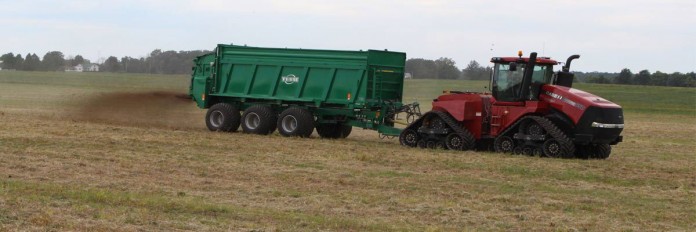Back-to-school shopping is winding down, and the morning air is starting feel a little more crisp. That means harvest is right around the corner. But before you get caught up in the hustle and bustle of harvest, don’t forget to take some time to plan ahead for fall manure applications.
Let’s talk about some key factors to consider before you start.
Soil testing
You’ve probably heard if before: you can’t manage what you don’t measure. If you don’t have a good handle on the nutrients available in your soil, it’s impossible to make smart nutrient applications for next year’s crop. We recommend pulling soil samples on a three-year rotation. When pulling samples, make sure your soil sampling plan includes pulling samples at the same time of year so that you can really compare apples to apples — or in this case phosphorus to phosphorus, as the case may be.
Soil sampling can be done through your local ag retailer, or you can pull samples yourself to be analyzed through your local soil and water conservation district or extension office. As a heads up, you may notice some slight differences on the recommendations based on your soil test results compared to previous years based on the new Tri-State Fertilizer recommendations.
Manure Testing
Once you know what your soil and upcoming crop’s needs are through soil testing, it’s time to take a look at your manure. Manure nutrient values are variable, and you’re always better to conduct a current manure nutrient analysis instead of relying on book values for nutrients.
In Ashland County, the SWCD board offers one free manure analysis annually for farmers who demonstrate up-to-date, accurate manure application records. Once you know the nutrient values of your manure, you can determine what rates you should apply to your fields after harvest. If you need help calculating your rates, your local soil and water conservation office can help. Application rates should not exceed Tri-State guidelines.
Forecasting
Now that you’ve measured your soil needs and the nutrient values of your manure, it’s time to manage your application. Always check the forecast to make sure predicted weather is appropriate for manure application.
Today’s farmers have great resources at their disposal. One of those tools is the Ohio Applicator Forecast (agri.ohio.gov/wps/portal/gov/oda/divisions/plant-health/resources/ohio-applicator-forecast), which helps determine the weather risk for nutrient applications based on precipitation, temperature and snow melt data and classifies that rise as no runoff expected, low risk, moderate risk or severe risk.
Another tool is FARM, the Field Application Resource Monitor tool from Ohio State. FARM allows producers to identify an area of interest and receive both 12- and 24-hour precipitation. Farmers can create an account to track multiple fields and even sign up to receive e-mail alerts.
No matter what forecasting tool you’re using, be sure to plan ahead. Get manure applications out early during those good weather windows and empty your manure storage as much as possible. Planning ahead and taking advantage of those weather windows helps prevent the need to spread on frozen or snow covered ground, which is not only bad for the environment and water quality, but it also risks sending the valuable nutrients you need off your farm fields where your crops can use them.
Record keeping
In today’s world, good record keeping is more important than ever. Even if you’ve done your job researching weather forecasts and risks, we all know Ohio’s weather can change at the drop of a hat and doesn’t always follow what’s predicted. So when it comes to record keeping, not only do you need to document applications rates and locations, but you also need to document weather conditions and forecasts.
If you’re old-school and like to keep those records in a notebook or a calendar in the milk house, that can work. But one tool the Ashland SWCD staff recommends is OnMrk, the Ohio Nutrient Management Record Keeper. This smart phone app is easy to use, secure, and it documents applications and allows you to manage farms and field with the touch of a button. In fact, Ashland SWCD has even put together some short videos to walk you through the process of using OnMrk at ashlandswcd.com/manure-testing.
Modeling
If you tackled all of the previous steps with ease and are starting to feel like an old pro and fall manure management, it may be time to step up your game and venture into nutrient modeling. Ashland SWCD has partnered with Ohio Farm Bureau and Sunrise Cooperative to offer the Adapt-N nutrient modeling tool to farmers in the Jerome Fork watershed. Adapt-N provides an in-depth look at available nitrogen in your farm fields and accounts for weather, precipitation, cover crop and nutrient applications including manure.
For more information on any of these programs or opportunities, be sure to contact your local soil and water conservation district.
STAY INFORMED. SIGN UP!
Up-to-date agriculture news in your inbox!













